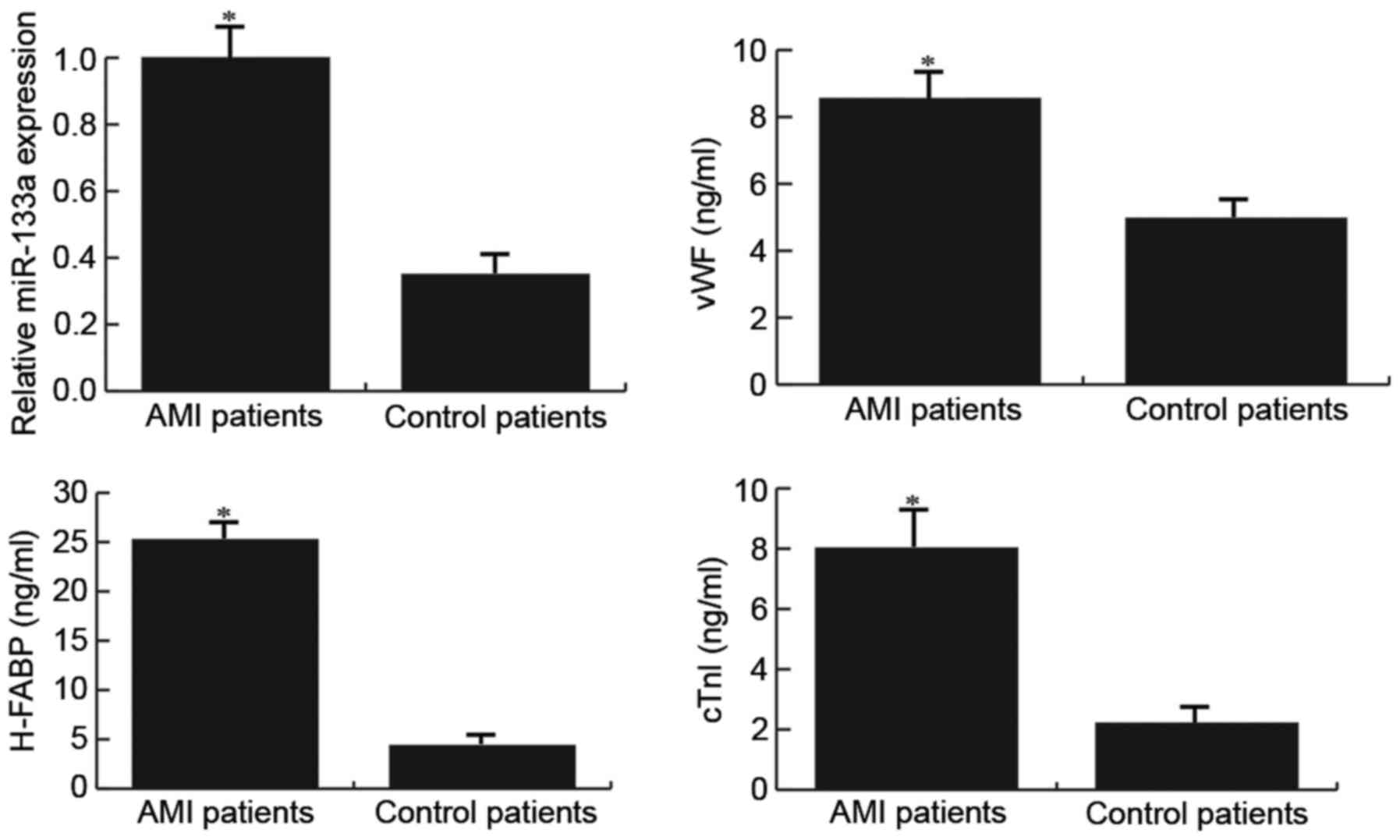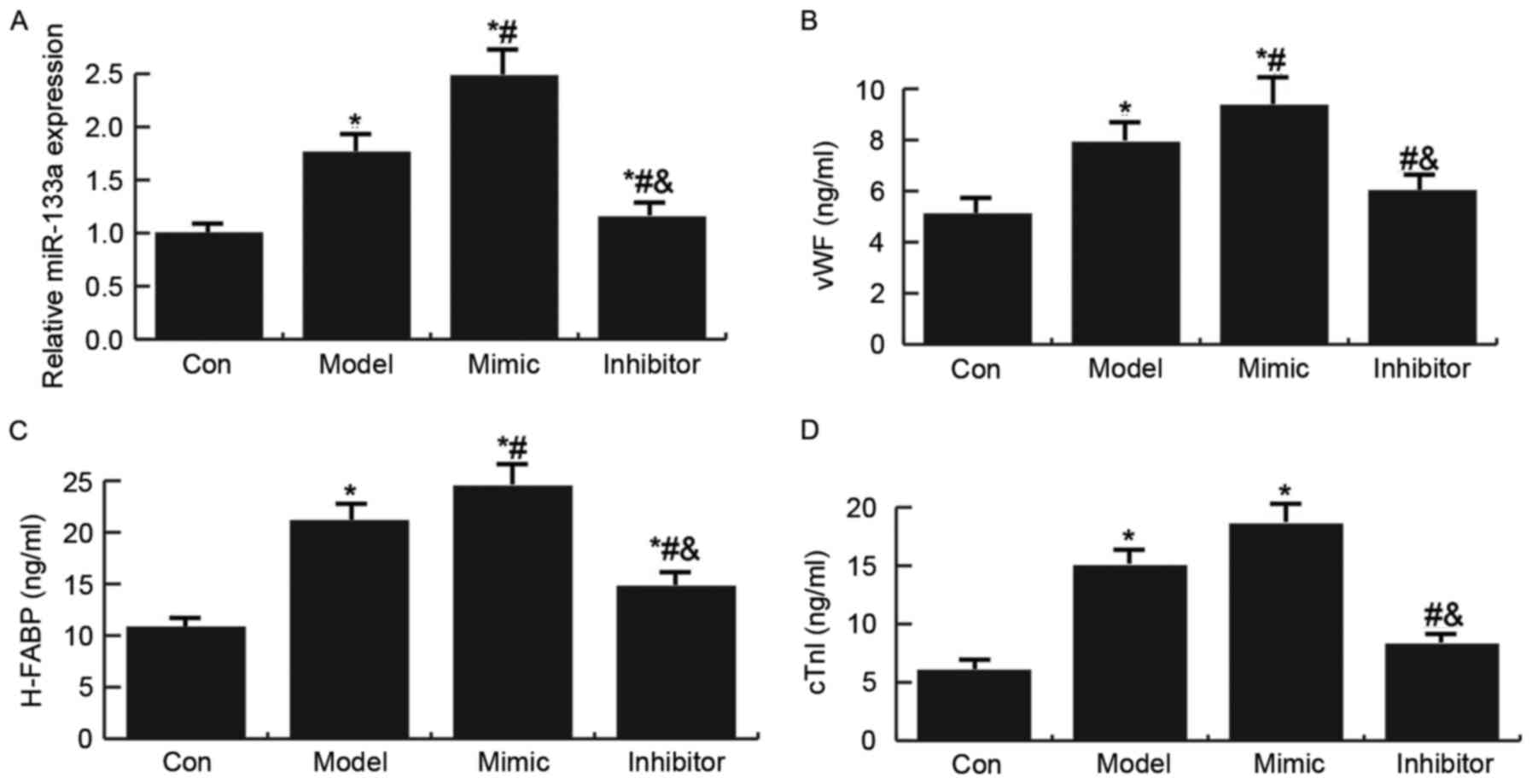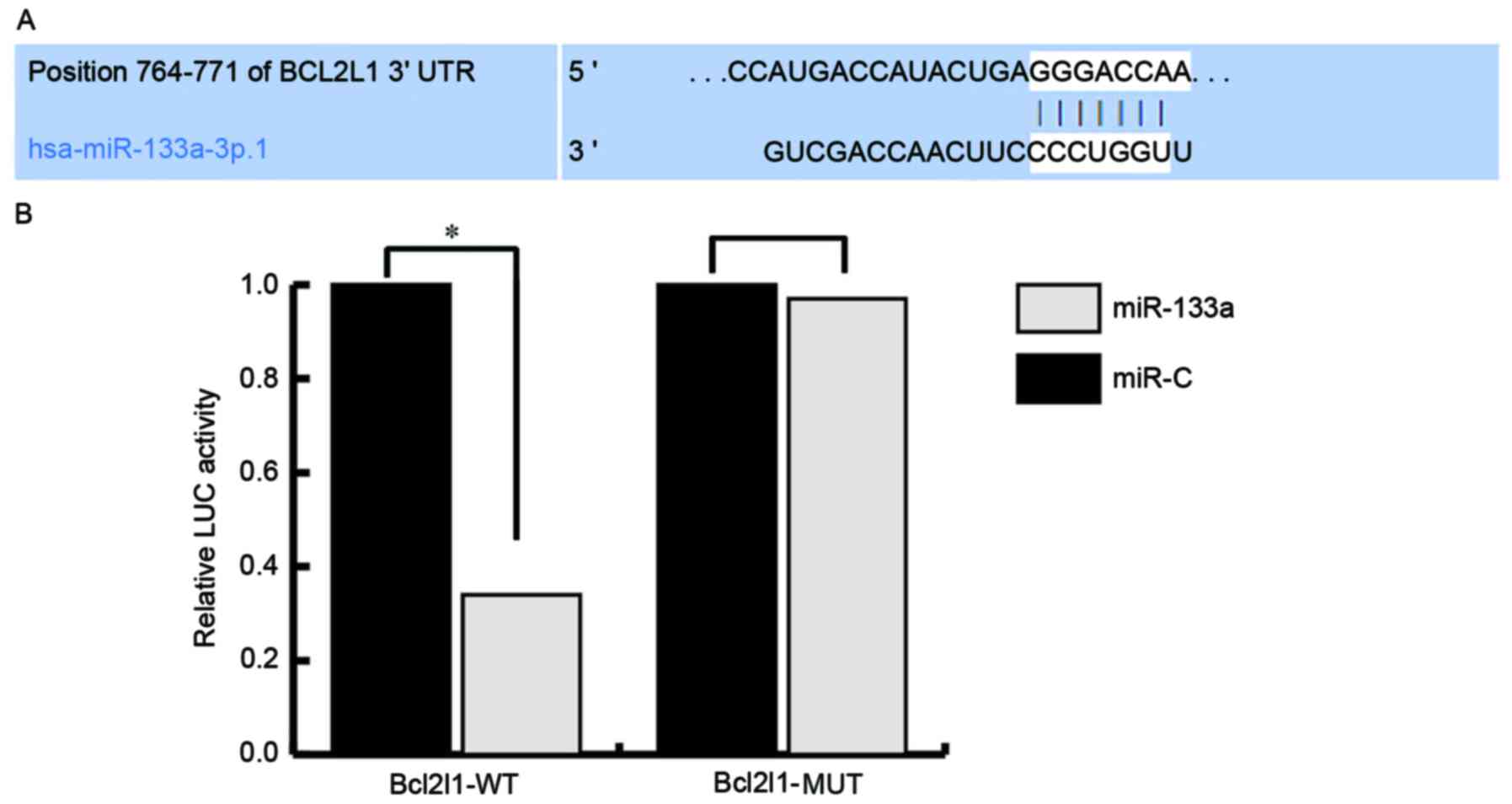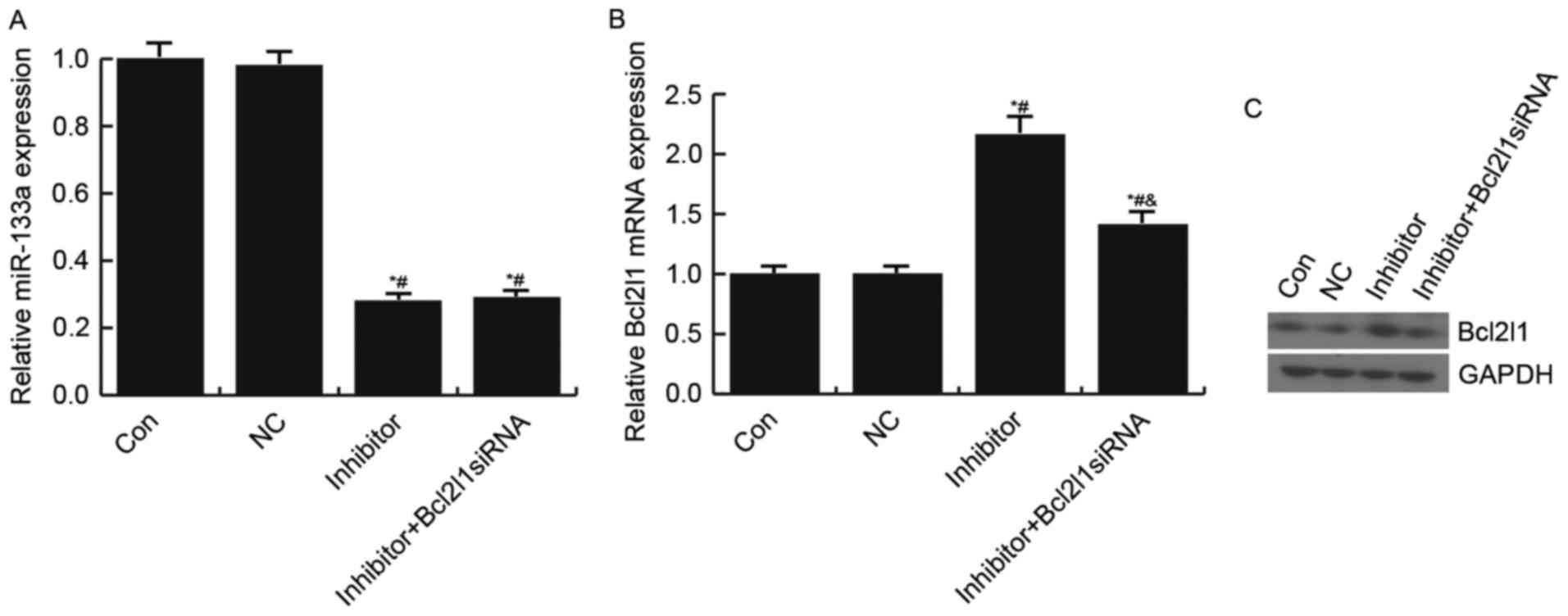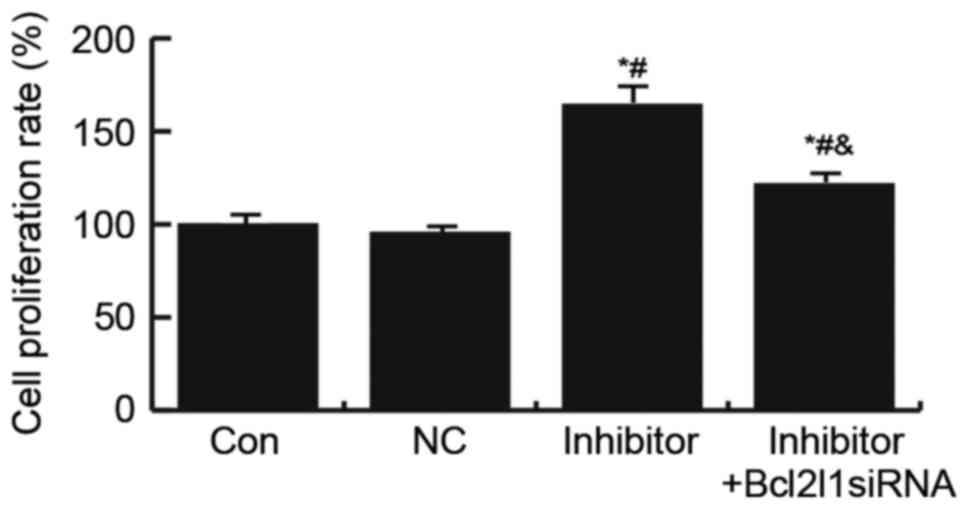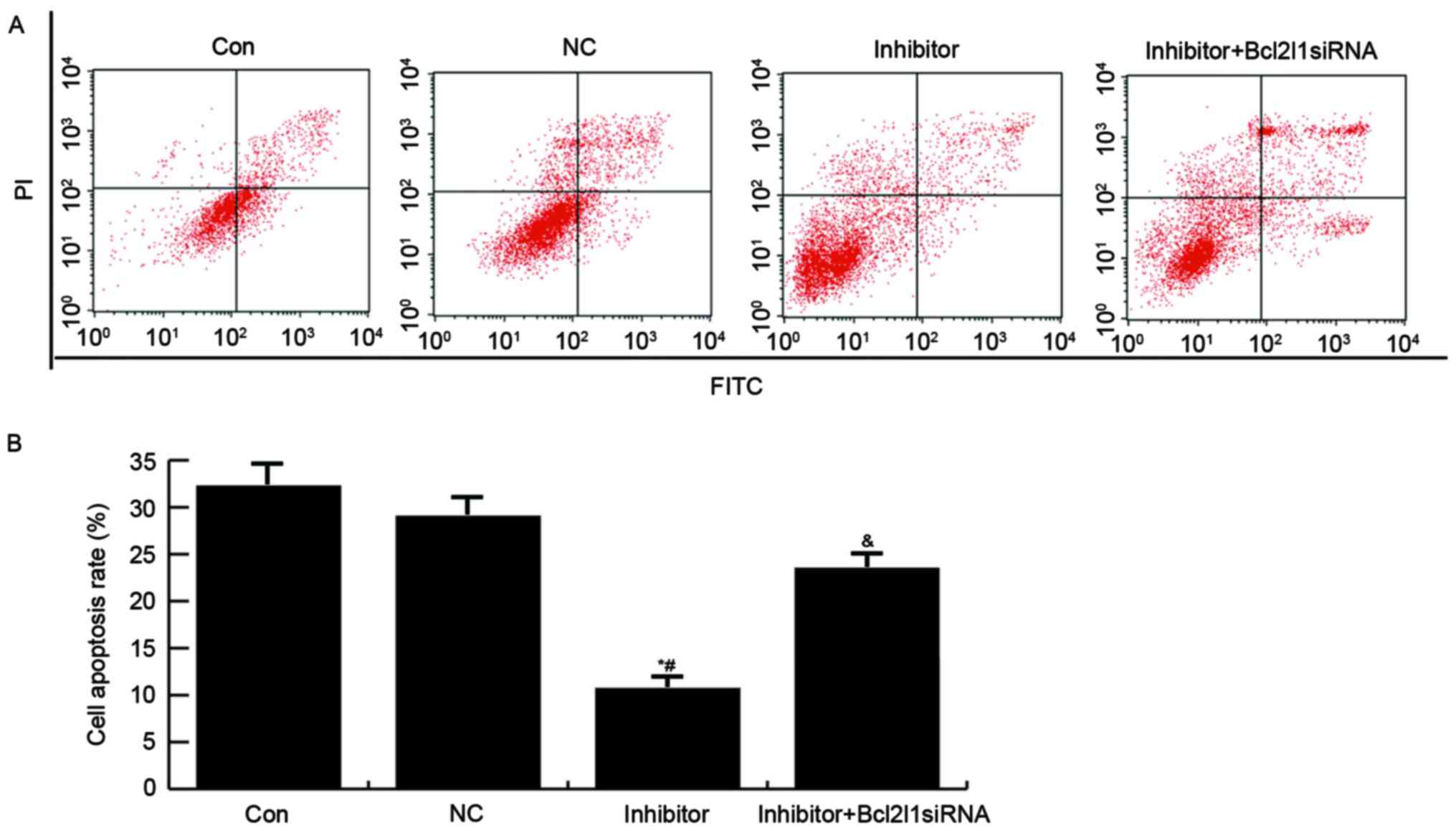Abnormal expression of miR‑133a in patients with acute myocardial infarction following radical surgery for gastric cancer and the underlying mechanism
- Authors:
- Published online on: October 10, 2018 https://doi.org/10.3892/mmr.2018.9541
- Pages: 5023-5029
-
Copyright: © Yu et al. This is an open access article distributed under the terms of Creative Commons Attribution License.
Abstract
Introduction
Gastric cancer (GC) is the fifth most common cancer worldwide and is considered a serious threat to human health, which negatively affects quality of life. The main treatment options for GC include surgery, chemotherapy and radiation therapy; however, each treatment is associated with complications. Surgery is the most common method of GC treatment and is a radical type of treatment: The primary tumor is resected along with the metastatic lymph nodes and the infiltrated tissue, with no tumor remaining (1). Cardiovascular complications are common in elderly patients with GC during the perioperative period and are the main cause of mortality in elderly patients following surgery. Acute myocardial infarction (AMI) is the most serious cardiovascular complication that threatens patient survival.
AMI, which is a serious cardiovascular disease (2), is characterized by inflammation, cardiomyocyte apoptosis and cardiac fibrosis (3). AMI is a primary disease that threatens human health due to its sudden onset, rapid progression and high mortality rate (4,5). It has previously been confirmed that there are no obvious clinical features in the early stages of AMI (6). AMI can result in left ventricular dilatation and heart failure, which can eventually lead to mortality (7). Therefore, the early discovery, diagnosis and treatment of this disease are important for the prognosis of patients with AMI.
MicroRNAs (miRNAs/miRs) are conserved, small, non-coding RNA molecules that negatively regulate the expression of target genes (8). Abnormal miRNA expression has been demonstrated in various diseases, particularly in cancer (9,10). Numerous studies have indicated that miRNAs participate in the occurrence and progression of cardiovascular diseases, including AMI (11–16). Liu et al reported that miR-150 serves a cardioprotective role in AMI via regulating monocyte cell migration and proinflammatory cytokine production (17). In addition, miR-92 is highly expressed in patients with AMI, and is involved in the endothelial injury process following AMI, whereas miR-92 inhibition may protect endothelial cells after AMI (18).
Previous studies have suggested that miR-133a expression is reduced in patients with GC (19), whereas it is highly expressed in patients with AMI (20) compared with in healthy controls. However, the expression of miR-133a in patients with or without AMI following radical surgery for GC remains unclear. The present study aimed to investigate the expression levels of miR-133a in patients with or without AMI following radical surgery for GC, and to explore its underlying mechanisms.
Materials and methods
Clinical samples
The present study was approved by the Human Ethics Committee Review Board at Cangzhou Central Hospital of Hebei (Cangzhou, China), and informed consent was obtained from all patients. A total of 20 blood samples were obtained from patients (age range, 46–74 years; sex ratio, 1:1) that were diagnosed with AMI 3 days after undergoing radical surgery for GC at Cangzhou Central Hospital of Hebei between February 2015 and December 2016. In addition, 20 blood samples were obtained from patients (age range, 44–71 years; sex ratio, 1:1) that did not suffer from AMI 3 days after undergoing radical surgery for GC. No patients had received any radiotherapy or chemotherapy prior to surgery. Blood samples were used to detect miRNA-133a and endothelial injury marker expression.
AMI rat model (21)
The rat study was approved by the Ethics Committee at Cangzhou Central Hospital of Hebei. A total of 20 male Wistar rats weighing 180–220 g were purchased from the Vital River Company (Beijing, China) and bred in standard conditions (temperature, 21±1°C; humidity, 55–60%). They were given water and food ad libitum. All the rats were anesthetized by intraperitoneal administration of pentobarbital (50 mg/kg), and then AMI rat models were established by ligating the left anterior descending coronary artery (LAD), as previously described (21). The control rats underwent a sham operation.
A miR-133a mimic (sense, 5′UUUGGUCCCCUUCAACCAGCUG3′ and antisense, 5′GCUGGUUGAAGGGGACCAAAUU3′); miR-133a inhibitor (5′CAGCUGGUUGAAGGGGACCAAA3′) and negative control (NC; sense, 5′UUCUCCGAACGUGUCACGUTT3′ and antisense, 5′ACGUGACACGUUCGGAGAATT3′) all obtained from Shanghai Pharmaceutical Technology Co., Ltd.; 2 µg mimic, inhibitor or NC in a total of 120 µl DMEM were injected into three areas of the myocardium of anterior left ventricular wall near the LAD during AMI surgery. The rats were then divided into four groups (18): Control group, in which 5 rats that underwent the sham operation were injected with a vector; model group, in which 5 rats in the AMI model group were injected with NC; miR-133a mimic group, in which 5 rats in the AMI model group were injected with a miR-133a mimic; miR-133a inhibitor group, in which 5 rats in the AMI model group were injected with a miR-133a inhibitor. All rats were sacrificed 3 days following LAD ligation. Then blood was collected from the retroorbital plexus and immediately flash-frozen in liquid nitrogen and stored at −80°C.
ELISA
To analyze the endothelial injury markers, including cardiac troponin I (cTnI; cat. no. Ab200016; Abcam, Cambridge, UK), heart-type fatty acid-binding protein (H-FABP; cat. no. CSB-E09185h; Cusabio Biotech Co., Ltd., College Park, MD, USA) and von Willebrand factor (vWF; cat. no. Ab108918; Abcam), blood samples from patients and rats were collected. Subsequently, ELISA analyses were performed according to the manufacturer's protocols.
Cell culture and transfection
Human umbilical vein endothelial cells (HUVECs) and the 293T cell line were obtained from the American Type Culture Collection (Manassas, VA, USA). HUVECs were cultured in endothelial growth medium (Gibco; Thermo Fisher Scientific, Inc., Waltham, MA, USA) in a humidified atmosphere containing 5% CO2 at 37°C. The 293T cells were grown in high glucose Dulbecco's modified Eagle's medium (Gibco; Thermo Fisher Scientific, Inc.) medium containing 10% fetal bovine serum (FBS; Gibco; Thermo Fisher Scientific, Inc.) at 5% CO2 and 37°C.
A miR-133a inhibitor (5′CAGCUGGUUGAAGGGGACCAAA3′; 100 nM), NC (sense, 5′UUCUCCGAACGUGUCACGUTT3′ and antisense, 5′ACGUGACACGUUCGGAGAATT3′; 50 nM) or 2 µl B-cell lymphoma 2 (Bcl-2)-like 1 (Bcl2l1) small interfering (si)RNA (cat. no. sc-43630; Santa Cruz Biotechnology, Inc., Dallas, TX, USA) were transfected into HUVECs (5×104 cells/well) using the Lipofectamine® LTX kit (Invitrogen; Thermo Fisher Scientific, Inc.) according to the manufacturer's protocol. The HUVECs were divided into four groups: The control group, in which cells were not transfected; the NC group, in which cells were transfected with NC; the inhibitor group, in which cells were transfected with a miR-133a inhibitor; and the inhibitor + Bcl2l1 siRNA group, in which cells were cotransfected with a miR-133a inhibitor and Bcl2l1 siRNA. Pre-experimental results demonstrated that Blc2l1 siRNA alone significantly decreased Bcl2l1 expression. Thus, the present study did not examine cells transfected with the Bcl2l1 siRNA alone.
Luciferase activity assay
To verify whether miR-133a directly targets the 3′ untranslated region (3′UTR) of Bcl2l1, Bcl2l1-3′UTR-wild type (WT) and Bcl2l1-3′UTR-mutant (MUT) vectors, containing wild type and mutated 3′UTR of Bcl2l1 mRNA respectively, were established as previously described (22). 293T cells were seeded in a 24-well plate (5×104 cells/well) and were then co-transfected with Bcl2l1-3′UTR-WT or Bcl2l1-3′UTR-MUT and 50 nM miR-133a or 100 nM NC vector using Lipofectamine® 2000 transfection reagent (Invitrogen; Thermo Fisher Scientific, Inc.) according to the manufacturer's protocol. Following transfection for 48 h, Luciferase activity was analyzed using a Dual-Luciferase Reporter Assay kit (Promega Corporation, Madison, WI, USA) according to the manufacturer's protocol.
Cell proliferation and apoptosis assays
A total of 48 h post-transfection, an MTT assay was applied to evaluate cell proliferation. Cells (3×103 cells per well) were seeded in a 96-well plate, and were incubated for 48 h followed by staining with 20 µl MTT (5 g/l) at 37°C for 4 h. Subsequently, the supernatant was discarded and the precipitate was dissolved following the addition of 200 µl dimethyl sulfoxide. The optical density value of each sample was measured at 490 nm using a spectrophotometer. Experiments were performed in triplicate. Cell apoptosis was determined using an Annexin V-fluorescein isothiocyanate (FITC)/propidium iodide (PI) Apoptosis Detection kit (BD Biosciences, Franklin Lakes, NJ, USA) using flow cytometry. In brief, 48 h following cell transfection, cells were rinsed with cold PBS. Cells (5×105 cells/well) were then labeled with Annexin V-FITC and propidium iodide, according to the manufacturer's protocol. Flow cytometry (BD Biosciences, Franklin Lakes. NJ, USA) was used for cell apoptosis analysis. WinMDI version 2.5 (Purdue University Cytometry Laboratories; www.cyto.purdue.edu/flowcyt/software/Catalog.htm) was used for data analysis and each test was repeated in triplicate.
Reverse transcription-quantitative polymerase chain reaction (RT-qPCR)
Total RNA was extracted from blood or cells using TRIzol reagent (Invitrogen; Thermo Fisher Scientific, Inc.) according to the manufacturer's protocol. GAPDH or U6 were used as internal controls. The PrimeScript RT reagent kit (Takara Bio, Inc., Otsu, Japan) was used to transcribe total RNA into cDNA according to the manufacturer's protocol. Amplification conditions for RT-PCR were as follows: 16°C for 30 min, 42°C for 30 min, 85°C for 5 min and holding at 4°C. qPCR analysis was conducted using SYBR Premix Ex Taq (Takara, Bio, Inc.). qPCR was conducted with following conditions: 95°C for 10 min, followed by 37 cycles at 95°C for 15 sec and 72°C for 30 sec. Relative gene expression was calculated using the 2−ΔΔCq method (23). Each experiment was performed in triplicate. The PCR primer sequences are listed in Table I.
Western blot analysis
Cells were harvested and lysed using radioimmunoprecipitation assay butter (Cell Signaling Technology, Inc., Danvers, MA, USA). A bicinchoninic acid protein assay kit (Beyotime Institute of Biotechnology, Haimen, China) was used for protein quantification. Protein samples (25 µg/lane) were separated by 12% SDS-PAGE and were then transferred to a polyvinylidene fluoride membrane. The membranes were blocked in Tris-buffered saline with 0.1% Tween® (TBST) with 5% skimmed milk for 1.5 h at room temperature. Subsequently, the membranes were incubated with primary antibodies against Bcl2l1 (cat. no. 2764; 1:1,000; Cell Signaling Technology, Inc.) and GAPDH (cat. no. 8884; 1:2,000; Cell Signaling Technology, Inc.) at 4°C overnight. After washing with TBST, the membranes were incubated with anti-rabbit IgG, HRP-linked Antibody (cat. no. 7074; 1:5,000; Cell Signaling Technology, Inc.) at room temperature for 4 h. Protein bands were visualized using enhanced chemiluminescence substrates (EMD Millipore, Billerica, MA, USA) and images were then captured.
Statistical analysis
SPSS 18.0 statistical software (SPSS, Inc., Chicago, IL, USA) was used to conduct all statistical analyses. Each experiment was repeated in triplicate. Data are presented as the mean ± standard deviation. Comparisons between two groups were performed using Student's t-test. Comparisons between multiple groups were performed using one-way analysis of variance followed by Tukey's post hoc test. P<0.05 was considered to indicate a statistically significant difference.
Results
Patients with AMI exhibit higher miR-133a and endothelial injury marker expression
The expression levels of miR-133a and endothelial injury markers were detected in patients with or without AMI following radical surgery for GC using RT-qPCR and ELISA, respectively. The results demonstrated that compared with the control patients, patients with AMI exhibited higher miR-133a and endothelial injury marker expression (Fig. 1).
miR-133a regulates endothelial injury marker expression
The present study also investigated the effects of miR-133a on endothelial injury marker expression in rats, following the establishment of an AMI rat model (21). As presented in Fig. 2, miR-133a expression was significantly increased in the AMI rat model; treatment with a miR-133a mimic further enhanced the expression of miR-133a, whereas miR-133a expression was decreased in the miR-133a inhibitor group. Compared with the control group, the expression levels of the endothelial injury markers (vWF, H-FABP and cTnI) were significantly increased in the AMI rat model. In addition, treatment with the miR-133a mimic enhanced the expression levels of endothelial injury markers (vWF, H-FABP and cTnI) in the AMI rat model, whereas the miR-133a inhibitor had the opposite effect.
miR-133a directly targets Bcl2l1 and regulates Bcl2l1 expression
To investigate the mechanisms underlying the effects of miR-133a on the regulation of endothelial injury, the target genes of miR-133a were investigated using TargetScan (http://www.targetscan.org/vert_71/) and miRanda (http://www.microrna.org/microrna/home.do) databases. Numerous target genes were discovered, including Bcl2l1. As Bcl2l1 serves critical roles in cell proliferation and apoptosis, Bcl2l1 was selected for further analysis. Subsequently, a luciferase activity assay was used to confirm the predictions. The results indicated that miR-133a directly targets Bcl2l1 (Fig. 3).
The present study also confirmed that miR-133a negatively regulated Bcl2l1 expression in HUVECs. Transfection with the miR-133a inhibitor significantly increased Bcl2l1 expression; however, this increase was reduced following transfection with the Bcl2l1 siRNA (Fig. 4).
Effects of miR-133a on HUVEC cell proliferation
To explore the underlying mechanisms of miR-133a in the regulation of endothelial injury, the present study determined the effects of miR-133a on HUVEC cell proliferation using an MTT assay. The results suggested that transfection with the miR-133a inhibitor significantly increased HUVEC cell proliferation, whereas this increase was abrogated by Bcl2l1 siRNA (Fig. 5).
Effects of miR-133a on HUVEC apoptosis
Finally, an Annexin V-FITC/PI Apoptosis Detection kit was used to analyze the effects of miR-133a on apoptosis of HUVECs. As presented in Fig. 6, compared with in the control and NC groups, the apoptotic rate of HUVECs was reduced in the miR-133a inhibitor group, whereas transfection with Bcl2l1 siRNA was able to reverse the miR-133a inhibitor-induced reduction in cell apoptosis.
Discussion
Taken together, the present study demonstrated that compared with the control patients, patients with AMI following radical surgery for GC exhibited higher miR-133a and endothelial injury marker expression. In addition, miR-133a could promote the expression of endothelial injury markers (vWF, H-FABP and cTnI), whereas miR-133a inhibition could promote HUVEC proliferation and reduce cell apoptosis by targeting Bcl2l1. These results indicated that miR-133a was associated with endothelial injury following AMI by targeting Bcl2l1.
With the extensive application of electrocardiograms, perioperative cardiovascular complications during surgery for gastrointestinal tumors have garnered attention. However, the causes of perioperative cardiovascular complications of gastrointestinal tumors are very complex. Elderly patients often have the pathological basis of atherosclerosis, which increases the risk of AMI (24). AMI seriously threatens human survival, particularly in patients with AMI following tumor surgery; therefore, it is necessary to explore AMI pathogenesis, and to research novel diagnostic markers and treatment methods.
miRNAs have been reported to be associated with cardiovascular diseases, due to their involvement in the regulation of a wide range of processes, including gene expression control (25). Numerous studies have reported that miRNAs participate in endothelial injury (26,27). Although a previous study has demonstrated that miR-133a expression is increased in the plasma of patients with AMI (20), the mechanism remained to be elucidated. The present study detected the upregulation of miR-133a and endothelial injury markers (vWF, H-FABP and cTnI) in patients with AMI. To elucidate the functional roles of miR-133a in AMI, a rat model of AMI was generated. The results demonstrated that miR-133a was able to promote the expression of endothelial injury markers (vWF, H-FABP and cTnI) in a rat model of AMI, whereas treatment with the miR-133a inhibitor had the opposite effect. These data indicated that miR-133a may participate in endothelial injury.
The original indication of improvement following MI is endothelial activation, determined by the enhanced cell proliferation ability and reduced apoptosis (28). To further investigate the underlying mechanisms of miR-133a in the regulation of endothelial injury in AMI, Bcl2l1 was initially identified as a direct target gene of miR-133a. The protein encoded by the Bcl2l1 gene belongs to the Bcl-2 protein family and functions as an anti-apoptotic molecule. The present study subsequently determined the effects of miR-133a on HUVEC cell proliferation and apoptosis. The results demonstrated that compared with in the control and NC groups, transfection with a miR-133a inhibitor was able to promote HUVEC proliferation and reduce cell apoptosis by upregulating Bcl2l1 gene expression.
In conclusion, the present study is the first, to the best of the authors' knowledge, to demonstrate that patients with AMI following radical surgery for GC had higher miR-133a expression compared with patients without AMI. In addition, the results indicated that miR-133a could regulate the endothelial injury process following AMI though the modulation of endothelial cells via targeting Bcl2l1. Therefore, miR-133a may be considered a novel therapeutic target in the future treatment of AMI; however, whether miR-133a may be targeted as a preventative intervention for AMI following radical surgery for GC requires further investigation.
Acknowledgements
Not applicable.
Funding
No funding was received.
Availability of data and materials
The analyzed data sets generated during the present study are available from the corresponding author on reasonable request.
Authors' contributions
JY collaborated in the design of the present study. JY, XC and YZ were responsible for data accession and analysis. JY, XC, YZ, LY and JW collaborated to interpret results and develop the manuscript.
Ethics approval and consent to participate
The present study was approved by the Human Ethics Committee Review Board at Cangzhou Central Hospital of Hebei (Cangzhou, China), and informed consent was obtained from all patients.
Consent for publication
Not applicable.
Competing interests
The authors declare that they have no competing interests.
References
|
Shi Y and Zhou Y: The role of surgery in the treatment of gastric cancer. J Surg Oncol. 101:687–692. 2010. View Article : Google Scholar : PubMed/NCBI | |
|
White HD and Chew DP: Acute myocardial infarction. Lancet. 372:570–584. 2008. View Article : Google Scholar : PubMed/NCBI | |
|
Bogomolov AN, Kozlov KL, Kurochkina ON and Olesiuk IB: Coronary stenting in elderly patients with acute myocardial infarction (review). Adv Gerontol. 26:151–160. 2013.(In Russian). PubMed/NCBI | |
|
Lipinski MJ, Escárcega RO, D'Ascenzo F, Magalhães MA, Baker NC, Torguson R, Chen F, Epstein SE, Miró O, Llorens P, et al: A systematic review and collaborative metaanalysis to determine the incremental value of copeptin for rapid rule-out of acute myocardial infarction. Am J Cardiol. 113:1581–1591. 2014. View Article : Google Scholar : PubMed/NCBI | |
|
Velibey Y, Erbay A, Ozkurt E, Usta E and Akin F: Acute myocardial infarction associated with blood transfusion: Case report and literature review. Transfus Apher Sci. 50:260–262. 2014. View Article : Google Scholar : PubMed/NCBI | |
|
Yahalom M, Roguin N, Suleiman K and Turgeman Y: Clinical signifcance of conditions presenting with ECG changes mimicking acute myocardial infarction. Int J Angiol. 22:115–122. 2013. View Article : Google Scholar : PubMed/NCBI | |
|
Mozarian D, Benjamin EJ, Go AS, Arnett DK, Blaha MJ, Cushman M, de Ferranti S, Després JP, Fullerton HJ, Howard VJ, et al: Heart disease and stroke statistics update: A report from the American Heart Association. Circulation. 131:e29–e322. 2015.PubMed/NCBI | |
|
Bartel DP: MicroRNAs: Target recognition and regulatory functions. Cell. 136:215–233. 2009. View Article : Google Scholar : PubMed/NCBI | |
|
Yang Z, Han Y, Cheng K, Zhang G and Wang X: miR-99a directly targets the mTOR signalling pathway in breast cancer side population cells. Cell Prolif. 47:587–595. 2014. View Article : Google Scholar : PubMed/NCBI | |
|
Niu G, Li B, Sun J and Sun L: miR-454 is down-regulated in osteosarcomas and suppresses cell proliferation and invasion by directly targeting c-Met. Cell Prolif. 48:348–355. 2015. View Article : Google Scholar : PubMed/NCBI | |
|
Sala V, Bergerone S, Gatti S, Gallo S, Ponzetto A, Ponzetto C and Crepaldi T: MicroRNAs in myocardial ischemia: Identifying new targets and tools for treating heart disease. New frontiers for miR-medicine. Cell Mol Life Sci. 71:1439–1452. 2014. View Article : Google Scholar : PubMed/NCBI | |
|
Thum T, Gross C, Fiedler J, Fischer T, Kissler S, Bussen M, Galuppo P, Just S, Rottbauer W and Frantz S: MicroRNA-21 contributes to myocardial disease by stimulating MAP kinase signalling in fbroblasts. Nature. 456:980–984. 2008. View Article : Google Scholar : PubMed/NCBI | |
|
Wang X, Zhang X, Ren XP, Chen J, Liu H, Yang J, Medvedovic M, Hu Z and Fan GC: MicroRNA-494 targeting both proapoptotic and antiapoptotic proteins protects against ischemia/reperfusion-induced cardiac injury. Circulation. 122:1308–1318. 2010. View Article : Google Scholar : PubMed/NCBI | |
|
Fiedler J, Jazbutyte V, Kirchmaier BC, Gupta SK, Lorenzen J, Hartmann D, Galuppo P, Kneitz S, Pena JT, Sohn-Lee C, et al: MicroRNA-24 regulates vascularity after myocardial infarction. Circulation. 124:720–730. 2011. View Article : Google Scholar : PubMed/NCBI | |
|
Hinkel R, Penzkofer D, Zühlke S, Fischer A, Husada W, Xu QF, Baloch E, van Rooij E, Zeiher AM, Kupatt C and Dimmeler S: Inhibition of microRNA-92a protects against ischemia/reperfusion injury in a large-animal model. Circulation. 128:1066–1075. 2013. View Article : Google Scholar : PubMed/NCBI | |
|
Devaux Y, Vausort M, McCann GP, Zangrando J, Kelly D, Razvi N, Zhang L, Ng LL, Wagner DR and Squire IB: MicroRNA-150: A novel marker of left ventricular remodeling after acute myocardial infarction. Circ Cardiovasc Genet. 6:290–298. 2013. View Article : Google Scholar : PubMed/NCBI | |
|
Liu Z, Ye P, Wang S, Wu J, Sun Y, Zhang A, Ren L, Cheng C, Huang X, Wang K, et al: MicroRNA-150 protects the heart from injury by inhibiting monocyte accumulation in a mouse model of acute myocardial infarction. Circ Cardiovasc Genet. 8:11–20. 2015. View Article : Google Scholar : PubMed/NCBI | |
|
Liu H, Li G, Zhao W and Hu Y: Inhibition of MiR-92a may protect endothelial cells after acute myocardial infarction in rats: Role of KLF2/4. Med Sci Monit. 22:2451–2462. 2016. View Article : Google Scholar : PubMed/NCBI | |
|
Gong Y, Ren J, Liu K and Tang LM: Tumor suppressor role miR-133a in gastric cancer by repressing IGF1R. World J Gastroenterol. 21:2949–2958. 2015. View Article : Google Scholar : PubMed/NCBI | |
|
Wang F, Long G, Zhao C, Li H, Chaugai S, Wang Y, Chen C and Wang DW: Plasma microRNA-133a is a new marker for both acute myocardial infarction and underlying coronary artery stenosis. J Transl Med. 11:2222013. View Article : Google Scholar : PubMed/NCBI | |
|
Zhang D, Zhu L, Li C, Mu J, Fu Y, Zhu Q, Zhou Z, Liu P and Han C: Sialyltransferase7A, a Klf4-responsive gene, promotes cardiomyocyte apoptosis during myocardial infarction. Basic Res Cardiol. 110:282015. View Article : Google Scholar : PubMed/NCBI | |
|
Zhang GJ, Zhou H, Xiao HX, Li Y and Zhou T: Up-regulation of miR-224 promotes cancer cell proliferation and invasion and predicts relapse of colorectal cancer. Cancer Cell Int. 13:1042013. View Article : Google Scholar : PubMed/NCBI | |
|
Livak KJ and Schmittgen TD: Analysis of relative gene expression data using real-time quantitative PCR and the 2(-Delta Delta C(T)) method. Methods. 25:402–408. 2001. View Article : Google Scholar : PubMed/NCBI | |
|
Agarwal S, Sud K, Thakkar B, Menon V, Jaber WA and Kapadia SR: Changing trends of atherosclerotic risk factors among patients with acute myocardial infarction and acute ischemic stroke. Am J Cardiol. 119:1532–1541. 2017. View Article : Google Scholar : PubMed/NCBI | |
|
Small EM and Olson EN: Pervasive roles of microRNAs in cardiovascular biology. Nature. 469:336–342. 2011. View Article : Google Scholar : PubMed/NCBI | |
|
Bonauer A, Carmona G, Iwasaki M, Mione M, Koyanagi M, Fischer A, Burchfield J, Fox H, Doebele C, Ohtani K, et al: MicroRNA-92a controls angiogenesis and functional recovery of ischemic tissues in mice. Science. 324:1710–1713. 2009. View Article : Google Scholar : PubMed/NCBI | |
|
Zhou J, Wang KC, Wu W, Subramaniam S, Shyy JY, Chiu JJ, Li JY and Chien S: MicroRNA-21 targets peroxisome proliferators-activated receptor-alpha in an autoregulatory loop to modulate flow-induced endothelial inflammation. Proc Natl Acad Sci USA. 108:10355–10360. 2011. View Article : Google Scholar : PubMed/NCBI | |
|
Tedgui A and Mallat Z: Cytokines in atherosclerosis: Pathogenic and regulatory pathways. Physiol Rev. 86:515–581. 2006. View Article : Google Scholar : PubMed/NCBI |



